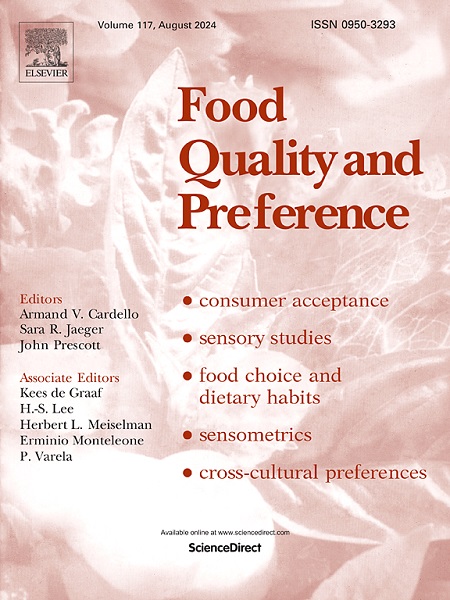Tasting in tune: The influence of music on taste evaluation under visual masking conditions
IF 4.9
1区 农林科学
Q1 FOOD SCIENCE & TECHNOLOGY
引用次数: 0
Abstract
This study investigates the effect of music on the evaluation of drinks presented unmasked (in open cups) or masked (in closed cups with opaque lids). Participants tasted five drink samples (varying in color and flavor) while listening to a sweet (SW) and a non-sweet (NS) soundtrack (within participants). Listening to the SW (vs. NS) soundtrack significantly increased the reported sweetness of drinks, whereas the NS (vs. SW) soundtrack increased sourness ratings. Moreover, participants liked the samples more and provided higher pleasantness ratings in the SW music condition. The visual masking manipulation (unmasked vs. masked) did not influence taste ratings. However, participants in the unmasked condition (n = 65) liked the samples more and rated them as more pleasant than those who tasted the masked samples (n = 63). Moreover, a significant interaction between music and visual masking suggested that music increased pleasantness ratings only when the samples were visible. In contrast, in the masked condition, pleasantness ratings remained nearly unchanged. These findings emphasize the potential of music for improving taste perception independently of visual cues. However, they also indicate that the use of opaque lids can worsen the hedonic experience and reduce some of the beneficial effects of music in a drinking situation.

求助全文
约1分钟内获得全文
求助全文
来源期刊

Food Quality and Preference
工程技术-食品科技
CiteScore
10.40
自引率
15.10%
发文量
263
审稿时长
38 days
期刊介绍:
Food Quality and Preference is a journal devoted to sensory, consumer and behavioural research in food and non-food products. It publishes original research, critical reviews, and short communications in sensory and consumer science, and sensometrics. In addition, the journal publishes special invited issues on important timely topics and from relevant conferences. These are aimed at bridging the gap between research and application, bringing together authors and readers in consumer and market research, sensory science, sensometrics and sensory evaluation, nutrition and food choice, as well as food research, product development and sensory quality assurance. Submissions to Food Quality and Preference are limited to papers that include some form of human measurement; papers that are limited to physical/chemical measures or the routine application of sensory, consumer or econometric analysis will not be considered unless they specifically make a novel scientific contribution in line with the journal''s coverage as outlined below.
 求助内容:
求助内容: 应助结果提醒方式:
应助结果提醒方式:


